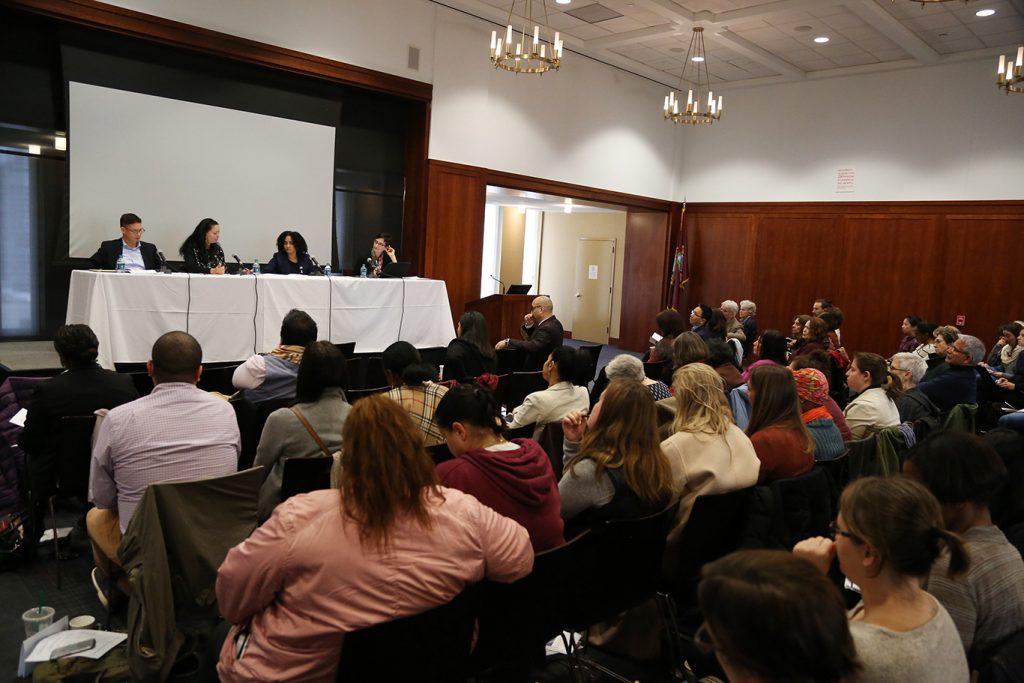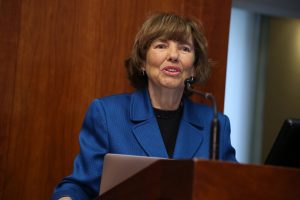
Photos by Michael Dames
Congress was referring to the strides the country has made over the last half century in welcoming immigrants from all over the world, as well as the threats to this progress that are making headlines daily. The paradoxical topic was the focus of the conference, “A Nation of Immigrants? 50 Years of the New Immigration,” which brought experts together to discuss a timely issue that has pivoted to the forefront of national debate.
Passed in 1965 and enacted in 1968, the Immigration and Nationality Act, also called the Hart-Celler Act and the Family Reunification Act, abolished the quota system established in the 1920s that discriminated against non-northern Europeans and set a historical new precedent for immigration in the United States.
‘Changing the Face of the United States’
“For 45 years, there was very little immigration from places other than northern Europe,” said Rafael Zapata, Fordham’s chief diversity officer. “The Hart-Cellar Act changed the face of the United States.”
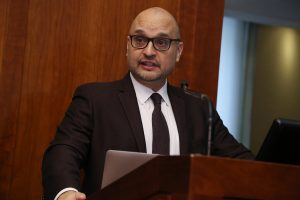
Keynote speaker Van Tran, Ph.D., a sociologist from Columbia University who has written extensively on the topic, agreed that the act has transformed American society, something he said President Lyndon Johnson and members of Congress didn’t foresee when it was signed. “The president said that the bill was not revolutionary,” he said. “The consensus was this will only open the door a little, maybe we could expect 5,000 people from Asia, a few hundred from Mexico, and a few hundred from Nigeria. Little did they know, it would open the door to roughly one million people a year.”
He said that at the time, there were also concerns about how immigrants would assimilate into American life. “Despite that, prior research shows clear evidence of social mobility and increased integration into American society among post-1965 immigrants and their children,” he said, noting that immigrants over the last 50 years have enriched American society with tremendous cultural, social, educational, and economic contributions.
Act at Center of Current National Immigration Debate
Tran and other scholars who presented at the conference noted the rise in anti-immigrant sentiment across the country since the last presidential election. Further, they said, as undocumented migrants continue to be separated and detained at U.S. borders, the Hart-Celler Act is at center stage in a heated national debate.
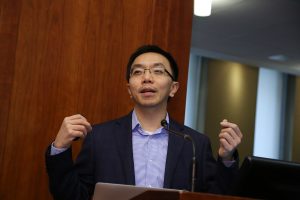
“I could speak for 10 hours about the host of policies and practices the Trump Administration has adopted that contravene the spirit and principle of family reunification,” said Dora Galacatos, executive director of the Feerick Center for Social Justice at Fordham Law School, at the panel discussion following the lecture.
“However, this is not the first. The Trump administration has built on the foundation that was started, sadly and tragically, by the Obama administration,” she said, referring to mass deportation and family detention as well as other “objectionable practices” that occurred during President Barack Obama’s tenure.
Anxiety and Mental Health Needs
Since 2016, Galacatos and a team of volunteers, including Fordham Law students, have made several visits to Dilley, Texas, home of the largest of three detention centers in the country, to assist asylum seekers and prepare them for interviews.
“We have seen extensive violations of federal law,” she said, sharing the story of one mother who was separated from her 9-year-old daughter upon entry and detained for weeks, at times handcuffed in solitary confinement and deprived of food and water.
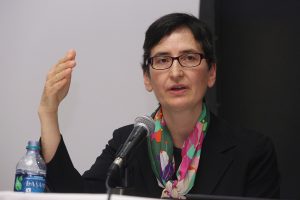
“She was told she would never see her daughter again, and that she would be adopted,” Galacatos said. “That is torture. We need to stand up and say that this is un-American and it is not right.”
Panelist Shirley Leyro, Ph.D., assistant professor of criminal justice at Manhattan Community College—CUNY, shared her experience of the immigration crisis at the local level, and particularly immigrants’ fear of deportation and resulting mental health issues. Panelist Maria Lizardo, executive director of the Manhattan Improvement Corporation, said she and her staff also started seeing heightened anxiety among their clients following the 2016 election.
“We are doing a lot of ‘know-your-rights workshops’ and emergency planning for folks with families that have mixed statuses,” she said, adding that her organization runs four settlement houses and provides housing, legal services, and public benefits advocacy to 14,000 people in Manhattan and the Bronx.
“They are worried about who will take care of their children if they get deported. This is the first time we’ve had to do this kind of work at the community level and have these tough conversations.”
All of the speakers agreed that the Hart-Celler Act is being challenged in ways it never has before, but that it may likely provide the catalyst for much-needed change. Tran sees a ray of hope in New York City, a place that he says can serve as a model for successful immigrant integration across the country. With immigrants comprising more than half of the city’s population of 8 million, and a “long history of immigration and cultural diversity, it is a particularly inclusive environment,” he said.
—Claire Curry
]]>Photo by Dana MaxsonFordham Law School’s Feerick Center for Social Justice was honored on May 9 by the American College of Trial Lawyers for its work on behalf of the Dilley Pro Bono Project.
In a ceremony held at the Lincoln Center campus, the group presented Feerick Center founder and director Professor John D. Feerick and executive director Dora Galacatos, LAW ’96, with a check for $100,000. The center will use the funds to expand its involvement with the Dilley Pro Bono Project in its efforts to assist asylum-seeking women with children detained in the South Texas Family Residential Center, a U.S. Immigration and Customs Enforcement facility in Dilley, Texas.
Since March 2016, the Feerick Center has partnered with the student-run group Immigration Advocacy Project to send 58 law student volunteers on 7 trips to Dilley, where they have provided legal representation to families seeking asylum in the United States. An additional 20 other volunteers (including Fordham Law School alumni and staff) have served on 4 other trips.
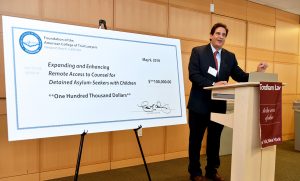
A large number of the clients are women and children fleeing countries with extremely high murder rates, such as Honduras, El Salvador, and Guatemala. Volunteers explain the process of applying for asylum, listen to clients’ stories, and help them prepare for interviews with asylum officers.
Galacatos said the need for resources has never been higher. With 2,400 beds, the Dilley facility is the largest immigration detention center in the country, and a recent census revealed that it’s nearly full, with 2,200 residents currently detained there.
“I’ve been doing this for two years, and I’ve never seen it that high. There just aren’t enough people going down there to make sure every client who asks for help it gets it,” she said.
She and her partners with the Dilley Pro Bono Project plan to use the funds to hire expert consultants and some time-limited grant-funded staff and to purchase training materials and webinars. She said she’s grateful for the support of the American College of Trial Lawyers, which promotes the importance of fair administration of justice.
Galacatos said the Dilley Pro Bono Project (previously called the CARA Pro Bono Project) has been devoted to this idea since its founding and that it is an ideal example of it in action. When the first family detention center opened in 2014 in Artesia, Mexico, there were no lawyers there to assist detainees and only 46 percent of asylum seekers were determined by officers to have credible fears of being in harm’s way in the country they were fleeing. By contrast, the vast majority of Dilly project clients are successful—well over 96%.
“My job as a lawyer, and our responsibility as officers of the court, is to promote due process, and make sure everyone has a fair opportunity to make their claims,” she said.
]]>The mentoring program was launched last September by the Feerick Center for Social Justice at Fordham Law as part of the consortium’s efforts to link people and programs throughout the University that focus on poverty or social justice.
Participants need only dedicate 16 hours to the effort, including training, said Dora Galacatos, senior counsel at the Feerick Center.
Volunteers will attend a series of five structured events for the transitioning youths from 5:45 to 7:30 p.m. on Feb. 9, 16 and 23, and March 2 and 9.
The first mentoring sessions, which were held last semester, drew a law professor and two undergraduate students. This semester, Galacatos said she hopes to recruit a graduate student, law student or professor who can bring several years of life experience to the initiative.
“If we had eight people, I would be thrilled,” she said. “Growing each semester is the most important thing.”
Working in the Bronx, Galacatos noted, brings Fordham closer to people who need the most help.
“The Bronx has long been identified as the borough of highest need,” she said. “It’s the place in the city with the greatest number of young people who want a mentor but don’t have one.”
Kathryn Newman (LAW ’09), a Feerick Center fellow, said that the adolescents really benefit from their interactions with volunteers.
“It’s been shown that this population is vulnerable to homelessness, and mentorship has been shown to help prevent that,” she said. “It’s a small population, but a very vulnerable population.”
Volunteers can expect a light and fun atmosphere that exposes mentees to positive socialization, said Shirley Salomon, mentoring coordinator for Good Shepherd Services, which helped launch the program with the Feerick Center.
“We plan activities that focus on getting to know people, how to start conversations and understanding diversity,” she said.
In addition to the mentoring program, Galacatos said the consortium will hold a luncheon on Feb. 11 to solicit ideas from faculty and staff. Too often, she said, members of the Fordham community are unaware of how many interests they have in common when it comes to service.
“Our next step is to continue to facilitate information-sharing and strengthen connections,” she said.
For more information, contact Kathryn Newman at (212) 636-7715 or [email protected], or visit www.fordham.edu/cosj/.
]]>Fordham Law’s Feerick Center for Social Justice helped organize a series of educational programs to inform tenants of their rights when their building goes into foreclosure. Workshops were held in Brooklyn, the Bronx, Queens, and Staten Island.
“This project targeted frontline personnel at community-based organizations and in the faith community, as well as those working in the local offices of elected officials,” said Dora Galacatos, Senior Counsel to the Feerick Center. “These individuals very frequently are the first to get requests for assistance from tenants.”
At each program location, a panel of landlord-tenant and foreclosure specialists addressed the scope of the problem of foreclosures for tenants, provided an overview of the foreclosure process and the legal rights of tenants, and reviewed options for affected tenants. In addition, project participants distributed fact sheets with additional information about tenants and foreclosures. Specific issues raised included payment of rent during a foreclosure, what to do if utilities are shut off, and the effect of foreclosure on a tenant’s credit history.
The workshops are part of the Feerick Center’s Tenants and Foreclosures Education Project in collaboration with the Justice Center of the New York County Lawyers’ Association (NYCLA). A planning committee for the project that convened in March included members from the Center for New York City Neighborhoods; the Furman Center for Real Estate and Urban Policy at NYU; Housing Court Answers, a service of the City-Wide Task Force on Housing Court; the Legal Aid Society; and Legal Services NYC.
]]>